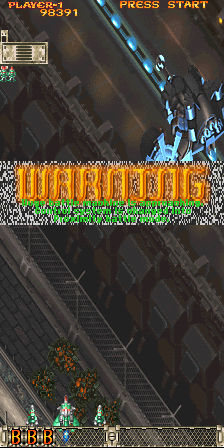Retro Replay Review
Gameplay
DoDonPachi: Dai-Ou-Jou on PS2 stays true to the manic 2D vertical-shooter formula that Cave pioneered. From the moment you launch into the first stage, you’re greeted by clouds of bullets filling the screen in intricate, hypnotic patterns. Dodging through this hailstorm demands razor-sharp reflexes and a deep understanding of each ship’s movement speed and hitbox. The thrill of threading your way through an ocean of projectiles creates an almost meditative focus, punctuated by heart-pounding near-misses.
(HEY YOU!! We hope you enjoy! We try not to run ads. So basically, this is a very expensive hobby running this site. Please consider joining us for updates, forums, and more. Network w/ us to make some cash or friends while retro gaming, and you can win some free retro games for posting. Okay, carry on 👍)
One of the most lauded additions to the PS2 port is Simulation Mode, where you can fine-tune nearly every gameplay parameter. Whether you want to tweak bullet density, adjust combo timings, or experiment with score multipliers, Simulation Mode gives you the sandbox to perfect your run. This level of customization transforms Dai-Ou-Jou from a static arcade experience into a living practice ground, ideal for both newcomers seeking to learn the ropes and veterans chasing every last point.
The game supports six distinct machine/pilot combinations, each with unique shot patterns, bomb effects, and speed options. Choosing the right pairing is more than cosmetic: it alters your approach to bullet patterns and boss battles. The Death Label mode, which pits you against super-powered versions of every major boss, offers the ultimate challenge. Here, surviving even a single phase becomes a badge of honor, while recording game replays lets you analyze each death and refine your tactics.
Graphics
Graphically, Dai-Ou-Jou embraces the hi-res polygonal backgrounds of the PS2 era without sacrificing the crisp 2D sprites that fans adore. Stages unfold with layered parallax scrolling, giving depth to deserts littered with mech wreckage, neon-lit futuristic cities, and eerie alien fortresses. The contrast between sharp enemy designs and dense bullet patterns is handled exceptionally well, ensuring visibility even when the screen is awash with orange and purple chakrams.
Enemy and boss animations are smooth and deliberate, each telegraphing attacks in subtle ways that reward careful observation. Bosses glow and shift prior to unleashing their most devastating moves, providing a sliver of a window to react. Visual effects for bomb explosions and scoring chains shine with metallic sheen and particle bursts, adding a tactile satisfaction to each well-timed countermeasure.
The PS2’s hardware also powers the replay system, which overlays ghost images of previous runs in real time. Watching your past selves weave through bullets and how you stack combos can be as visually captivating as it is instructive. Whether you’re playing on a CRT or upscaling on a modern HDTV, Dai-Ou-Jou’s art direction holds up, marrying classic bullet-hell aesthetics with a subtle sheen of console polish.
Story
In true arcade shooter fashion, the narrative in DoDonPachi: Dai-Ou-Jou takes a backseat to the action, but there’s still a loose sci-fi setup driving the carnage. You pilot elite ships to quash an unknown alien armada threatening Earth’s last frontline. Brief text interludes between loops hint at a deeper conspiracy, as the distinctions between friend and foe blur in successive attack waves.
While you won’t find branching dialogue trees or lengthy cutscenes, the story serves its purpose: it gives context to the escalating bullet storms. Each mission briefing teases boss capabilities, setting your expectations before the level’s crescendo. This minimalism has a certain charm—by stripping story down to its essence, Dai-Ou-Jou keeps you locked into the cockpit rather than flicking through dialogue boxes.
For lore enthusiasts, the game booklet and on-screen annotations reference characters and previous DonPachi operations, weaving a modest mythos around the series’ iconic ships. If you dive into the broader DonPachi universe, you’ll appreciate the nods to past installments, though they never bog down the experience. Ultimately, the brief narrative beats function like seasoning—flavorful but never overpowering the main course of nonstop action.
Overall Experience
DoDonPachi: Dai-Ou-Jou on PS2 stands as one of the premier console bullet-hell shooters, offering depth for hardcore fans and accessibility for newcomers. The addition of Simulation Mode and replay recording elevates the title from an arcade port to a comprehensive training tool. You can jump in for a quick session or commit to multi-hour practice runs, chasing higher scores and mastering each of the six pilot/ship configurations.
The balance between brutal difficulty and rewarding mechanics is finely tuned. Early levels ease you into the frenetic pace, but by the third stage, you’ll understand why “bullet hell” is more than just marketing hype. The adrenaline rush of narrowly escaping a laser grid, combined with the dopamine hit of chaining a 100-hit combo, creates an experience that’s both exhilarating and addictively replayable.
Whether you’re building your skills in Death Label mode or simply enjoying the spectacle of a perfectly executed boss fight, Dai-Ou-Jou delivers on every front. Its polished graphics, relentless gameplay, and subtle narrative framework form a cohesive package that’s ideal for any shooter aficionado. For those seeking a relentless, high-octane journey through waves of aesthetically striking bullets, DoDonPachi: Dai-Ou-Jou remains a must-own on the PS2.
 Retro Replay Retro Replay gaming reviews, news, emulation, geek stuff and more!
Retro Replay Retro Replay gaming reviews, news, emulation, geek stuff and more!









Reviews
There are no reviews yet.